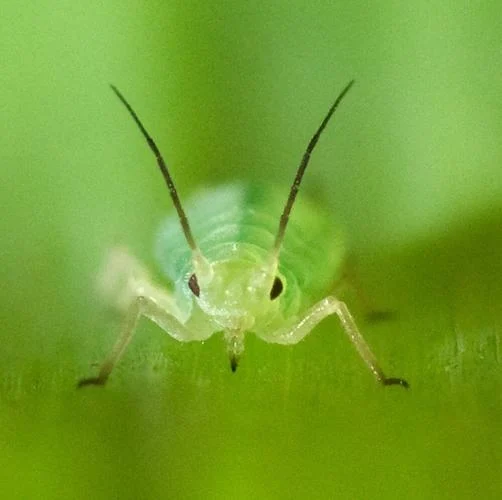Why the world isn’t knee-deep in aphids
By Julie Banken
WSU Chelan/Douglas County Master Gardener


In late spring, when the light lasts longer and the days and nights warm up, aphids begin to emerge from their eggs. These aphids are all females. Once they reach adulthood, they disperse and begin to reproduce parthenogenetically, cloning themselves without mating. They are viviparous, so instead of laying eggs, their offspring are “born” rather than hatched.
The job of these aphids is to start new colonies. They are very good at what they do! A female aphid can live for about a month, and when resources are plentiful, will produce between 50 and 100 wingless offspring in her lifetime.
In warm weather, it only takes about a week for newborn nymphs to reach adulthood, at which point they will also start cloning themselves. Just one adult aphid, then, could spawn a population of billions.
That many aphids could do some serious damage. Aphids eat by plugging their straw-like mouthparts into a plant. They go for the phloem, where liquid sugars made through photosynthesis are under pressure in the plant’s vascular system. They need to ingest a lot of juice from a plant to glean enough amino acids and nitrogen to thrive. If enough aphids are present, they can siphon off too much sap from their host, causing new leaves to pucker and curl and reducing the plant’s vigor.
Fortunately for the aphids, they have internal overflow valves for releasing some of the abundance of sap that squirts out of the plant and into their digestive system.
Unfortunately for gardeners, the extra plant sap which flows out of the aphids keeps flowing, right onto the leaves of the plant. This sticky mess is called honeydew.
Unless you are an ant, honeydew is pretty unappealing in the garden. It can also be a medium for sooty black mold which can block light and prevent leaves from photosynthesizing. It’s a good thing not all of the offspring from those first spring aphids will survive. They are easy prey for a long list of predators.
Aphids are wingless, in most cases, until the fall mating generations emerge. Because their mouthparts stay injected into the plant, they are not able to make a quick escape. Their best defense is to secrete a warning pheromone out their cornicles when they are attacked, alerting others nearby to danger. Lucky aphids can fall off a leaf to escape a predator, but they can’t fly, jump, or even run.
The most famous aphid-eater is the ladybug, whose aggressive black and red larvae look and act more like crocodiles than caterpillars. Other natural enemies of aphids include syrphid flies, snakeflies, green and brown lacewings, earwigs, big-eyed bugs, damsel bugs, rove beetles, soldier beetles, ground beetles, praying mantises, and many species of tiny parasitic wasps. Aphids are food for many other animals besides insects, too. Spiders, lizards, frogs, toads, and even small birds feed on them, keeping their population in check.
The main reason aphids reproduce rapidly is to counter the fact that so many animals rely upon them for food. The best way to keep aphid populations low is to provide a healthy habitat for their predators.
Using pesticides to kill aphids actually can improve their ability to multiply, since pesticides will also reduce the populations of their natural enemies. Because they have so many offspring, it is much easier for aphids to achieve resistance to a pesticide than it is for other species.
In small numbers, aphids do little damage to well-watered, healthy plants. Their presence invites a rich diversity of life into our gardens and yards.
